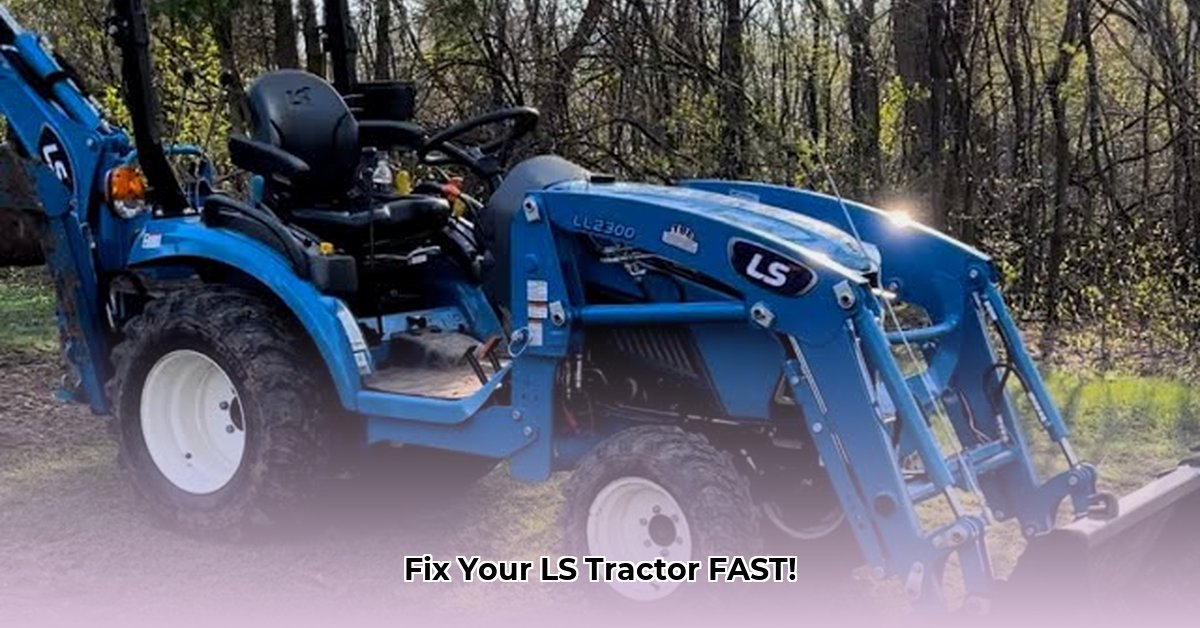
Keeping your LS tractor running smoothly is vital for efficient farming. This guide provides actionable solutions to common LS tractor problems, focusing on fast fixes and preventative maintenance. We'll cover engine issues, hydraulic problems, and more, equipping you with the knowledge to minimize downtime and maximize productivity. For more in-depth troubleshooting, check out this helpful resource.
Understanding Common LS Tractor Problems
Unexpected tractor issues can disrupt operations, causing delays and financial losses. Fortunately, many common LS tractor problems are easily diagnosed and resolved with basic tools and a proactive approach. This section details frequent problems and their solutions, enabling you to quickly get back to work.
Engine Starting Issues: Getting Your Tractor Fired Up
A common reason for a tractor failing to start is a dead battery. Before assuming a major problem, inspect battery terminals for corrosion. Clean any corrosion using a wire brush and baking soda paste. If the issue persists, a new battery might be necessary.
Another frequent cause is a clogged fuel filter, preventing fuel from reaching the engine. Replace this filter (consult your owner's manual for specific instructions). Only use high-quality fresh diesel fuel – old fuel can lead to various engine problems.
Engine Stalling and Rough Running: A Jittery Engine
An engine that stalls or runs roughly often indicates fuel delivery problems. This could involve a partially clogged fuel filter or a more serious issue like a faulty fuel injection pump. A clogged air filter also causes sputtering and poor engine performance. Regularly changing the air filter is crucial preventative maintenance. If these checks fail to resolve the problem, professional assistance is recommended because a faulty injection pump requires specialized repair.
Overheating: Keeping Your Tractor Cool
Overheating can cause serious engine damage. Common causes are low coolant levels, a faulty thermostat, or a blocked radiator. Regularly monitor and replenish coolant levels (check the owner's manual for specifications). Clean the radiator fins frequently to maintain optimal airflow and prevent overheating. Replace a malfunctioning thermostat promptly to prevent recurrence.
Steering Problems: Maintaining Control of Your Tractor
Steering difficulties often originate from hydraulic system issues. Addressing these problems is crucial for safe operation. Low hydraulic fluid is easily addressed by checking fluid levels and adding fluid as needed. However, more severe issues, such as a faulty hydraulic pump or damaged seals, require professional repair. Regularly checking and topping off hydraulic fluid is a key preventative measure. Any unusual whining or groaning noises from the hydraulics may indicate a failing pump.
Preventative Maintenance: An Ounce of Prevention
Preventative maintenance is far more cost-effective than reactive repairs. Regular maintenance extends the lifespan of your LS tractor and ensures consistent performance.
Monthly Maintenance: * Check all fluid levels (engine oil, coolant, hydraulic fluid, transmission fluid). * Inspect belts and hoses for wear or damage. * Thoroughly clean the radiator to remove debris. * Visually inspect for loose connections or leaks.
Every 50 Operating Hours: * Change engine oil and filter. * Replace the air filter (especially important in dusty environments).
Annually: * Replace fuel filters. * Inspect the battery and ensure proper charging. * Lubricate all moving parts. * Conduct a thorough visual inspection of the tractor.
Always consult your owner's manual for model-specific maintenance recommendations.
Troubleshooting Table: A Quick Reference Guide
| Problem | Possible Causes | Solutions |
|---|---|---|
| Engine Won't Start | Dead battery, clogged fuel filter, old fuel | Check battery and terminals, replace fuel filter, use fresh fuel |
| Engine Stalling | Fuel delivery issues, clogged air filter | Check fuel system, replace air filter |
| Engine Overheating | Low coolant, blocked radiator, faulty thermostat | Add coolant, clean radiator, replace thermostat |
| Steering Problems | Low hydraulic fluid, damaged hydraulic pump | Add fluid, repair or replace pump |
The Impact of Tractor Problems: Beyond Individual Farms
LS tractor problems extend beyond the individual farmer. Downtime leads to reduced yields and lost income; dealers experience increased service demands. Delays ripple through the entire agricultural supply chain. Preventative maintenance reduces these negative impacts, improving overall efficiency and profitability.
Looking Ahead: Continuous Improvement
While this guide covers frequent LS tractor issues, ongoing research and development continually enhance our understanding of these machines. New diagnostic tools and repair techniques constantly emerge. Staying informed via your dealer, online forums, and manufacturer updates ensures peak performance. Remember, consistent preventative maintenance minimizes repairs.
How to Prevent Common LS Tractor Engine Problems in Sustainable Farming
Proactive maintenance is key to preventing costly engine repairs. Using OEM parts ensures optimal performance and longevity. Understanding the Diesel Particulate Filter (DPF) regeneration process is crucial to prevent costly issues. Addressing warning lights promptly prevents minor problems from becoming major ones. Finally, planning for major component replacements is sound long-term management.
Key Takeaways:
- Regular maintenance is vital for preventing costly repairs.
- Using OEM parts ensures optimal component performance and longevity.
- Understanding DPF regeneration is crucial for preventing costly repairs.
- Addressing warning lights promptly can prevent escalating problems.
- Proactive planning for major component replacements is a smart long-term strategy.